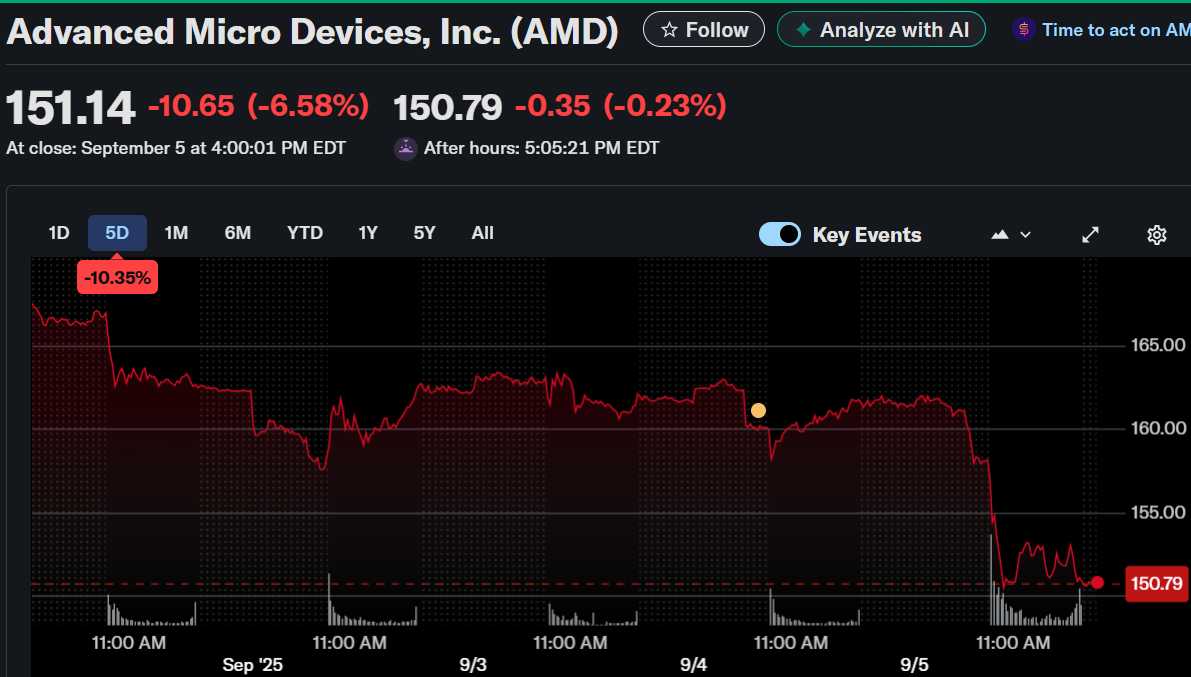Advanced Micro Devices (NASDAQ: AMD) stock fell 6.28% to $151.63 as of September 5, 2025, after analysts issued new updates on its AI business outlook.

Advanced Micro Devices, Inc. (AMD)
Seaport Global’s Jay Goldberg cut AMD to a “Hold” from “Buy,” citing supply chain checks that suggested weaker demand for the company’s AI accelerators.
Citi’s Christopher Danely reaffirmed a Hold rating with a $180 target price, while Bank of America’s Vivek Arya remained bullish with a Buy rating and $200 target. Arya’s target implies nearly 25% upside from current levels.
$AMD Downgrade ⚡ Analyst Flags Weak AI Momentum
🔹 Seaport cuts rating to Neutral
🔹 Slower adoption & budget reviews weigh
🔹 Stock trades $161, avg. target $184.91https://t.co/1pKyhBOSKF— MoneyCheck (@MoneyCheckCom) September 5, 2025
The broader semiconductor sector continues to feel pressure from escalating U.S.-China trade disputes. A new policy requires AMD, Nvidia (NASDAQ: NVDA), and Intel (NASDAQ :INTC) to direct 15% of China-derived revenue to the U.S. government. This mandate adds further strain on companies already balancing heavy investments in AI and advanced chip manufacturing.
Despite the recent drop, AMD shares are still up 25.55% year-to-date, compared with the S&P 500’s 9.97% gain. Over the past year, AMD gained 8.76%, lagging behind the index’s 17.53%. Longer-term returns remain robust, with three-year gains of 89% against the S&P 500’s 64.82%, and five-year gains of 84.92% versus 88.74%.
As of September 4, 2025, AMD’s market capitalization stood at $262.56 billion, with an enterprise value of $260.58 billion. The stock trades at a trailing P/E of 96.88 and a forward P/E of 27.17, reflecting high growth expectations. Its PEG ratio of 0.50 indicates favorable long-term growth potential relative to valuation.
On a profitability front, AMD reported a 9.57% profit margin, with return on assets of 2.19% and return on equity of 4.70%. The company generated $29.6 billion in trailing twelve-month revenue and $2.73 billion in net income, translating into diluted EPS of $1.67.
AMD maintains a solid balance sheet with $5.87 billion in cash and a low debt-to-equity ratio of 6.51%. Levered free cash flow stood at $2.33 billion. These metrics give AMD financial flexibility as it invests heavily in AI accelerators and EPYC server processors.
Wall Street maintains a Moderate Buy consensus, with an average price target of $184.91, suggesting about 15% upside from current levels. The success of AMD’s MI355 AI chip and server platforms will be crucial as analysts weigh near-term demand risks against longer-term AI adoption trends.
The post AMD ($AMD) Stock: Drops as Analysts Signal AI Demand Concerns Amid Trade Pressures appeared first on CoinCentral.
Also read: Crypto Biz | Gold Goes Digital